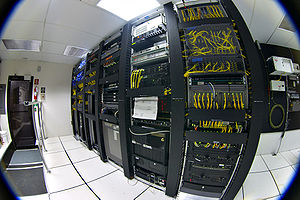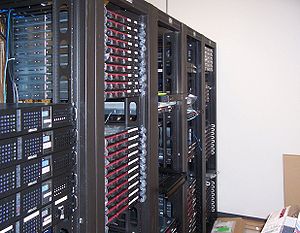 Last evening Google unveiled Google Apps Marketplace, an one-stop shop for SaaS business applications that are tightly integrated with Google Apps. Zoli covered the launch from Google Event and Ben did some analysis from the SMB perspective. I am going to take a different approach and cover some of the launch partners from the cloud computing space. Before I talk about the companies that launched in the marketplace, let me slip in some of my thoughts on this announcement.
Last evening Google unveiled Google Apps Marketplace, an one-stop shop for SaaS business applications that are tightly integrated with Google Apps. Zoli covered the launch from Google Event and Ben did some analysis from the SMB perspective. I am going to take a different approach and cover some of the launch partners from the cloud computing space. Before I talk about the companies that launched in the marketplace, let me slip in some of my thoughts on this announcement.
Long before rumors of Google Apps Marketplace even surfaced in the internet and almost a year after Zoli clamored for Google’s entry into the business applications market, I fantasized about Gmail as an enterprise dashboard. People might have called me crazy at that time but I loved the idea of using the Gmail as a dashboard for all my activities.
I also want to point out that it is now possible to add any Google gadgets, including those developed by third party vendors, to Gmail. Who needs expensive Exchange Server and Sharepoint Server when you can have similar capabilities within a browser for a fraction of its cost? Before people jump on me for this assertion, I want to highlight the fact that I am talking about what could happen in the future than the current state of Google SaaS products.
Yesterday’s announcement was more like my dream come true. Well, I wanted a much deeper integration but it is a good beginning. From what I hear from many of the SaaS vendors, a deeper integration is in the roadmap for all of them.
Even though Ben has spoken from the SMB angle, I feel that this move by Google increases the relevancy of SaaS in the enterprise segment in a big way. One of the biggest obstacles for the enterprise adoption of SaaS is the issue of identity management. With the release of Google OpenID Federated login API, Google Apps became the identity hub of SaaS. The next logical step is to deeply integrate Google Apps with different SaaS applications and wait for the customers to jump in. With the release of Apps Marketplace, Google took the necessary step for this transition.
Check out this video giving an overview on Google Apps Marketplace
Google launched the App Marketplace with 50 launch partners. It is not possible for me to cover all of them. I will select four of them from the briefings I got and talk about how their apps are integrated with Google Apps. There is a common theme to all the apps. They are
- Installing the app from the Google App Marketplace that shows up in Google Apps Admin Dashboard, much like other Google App services
- The installed apps show up in the Google universal navigation (the links available on the left top side on all of the Google applications)
- Integration of third party apps with Google apps and sharing of data
Zoho: Zoli has covered a bit about Zoho (disclaimer: Zoho is the exclusive sponsor of Cloud Ave) on this post yesterday. At this time, Zoho is integrating two of their business applications, Zoho CRM and Zoho Projects, with Google Apps. They have done some tighter integrations like the ability to import users from Google Apps, import contacts from Google Apps to CRM, subscribe and view events in CRM and Projects, attach Google Docs inside CRM and Project, etc.. This helps Zoho reach out to Google Apps users by offering a solid portfolio of business applications including Zoho CRM and Zoho Project. With the availability of Opensocial gadgets for Zoho CRM and Project, the data in these apps can be accessed from inside of Gmail. I asked Zoho evangelist, Raju Vegesna, about how deeply their products are going to integrated with one another in the future. He told me that we can expect much deeper integration with features like automatic sync of Google Contacts and Zoho CRM contacts, etc.. As a power Google Apps user and a Zoho CRM user, I can’t wait to have this kind of deeper integration. Exciting times are ahead for SaaS interoperability and integration.
Check out this video about Zoho CRM integration with Google Apps.
Socialwok: Socialwok is another favorite app of mine. Socialwok adds a social layer on top of Google Apps and offers a deeper integration with Google Apps services like calendar and docs. Socialwok, the winner of the Techcrunch 2009 demopit award, also runs on the Google infrastructure. It is built on top of Google App Engine. Already, they had made available a Google gadget which integrates well into Gmail. Now, Socialwok is even more integrated with Gmail, vastly simplifying the workflow and enhancing the collaboration further. I strongly recommend this app for any business with a distributed team.
Atlassian: Atlassian, the company behind the famous products like Jira, Confluence, etc., is also part of the Google Apps marketplace. Jira Studio, the fastest growing Atlassian product that offers developers a hosted software development suite, is now tightly integrated with Google Apps and it is available in the Marketplace. This integration allows developers to attach Google docs to any issue, embed any Google doc or list of docs into their wiki, Jira studio activity bar which shows unread message from gmail, calendar notification, open issues, etc. is available at the bottom of any page in studio and it is integrated with Google talk as well.
Check out this video about Jira Studio integration with Google Apps.
Skytap: Of all the partners, I was surprised to find Skytap in the list of Google Apps Marketplace launch partners. Unlike the other three I have covered above, Skytap is a cloud infrastructure provider (see my previous coverage of Skytap here, here and here). By integrating with Google Apps, Skytap is allowing users to log into their UI with Google Apps login, solving one of the biggest identity related problems faced by enterprises. But the most interesting part is the ability to run any enterprise apps, including legacy apps, on the Skytap cloud and access it from inside of Gmail. In my opinion, this is a true game changer and boosts the value of Google Apps among the enterprises.
For example, by using Skytap and Google Apps together, a sales engineer can instantly toggle between an enterprise application demo running in the Skytap Cloud to a Google Calendar application that contains necessary information to complete a task. Application developers and testers can move enterprise resource (ERP) applications to the Skytap Cloud without any code changes, migrate to a newer version, create application snapshots, maintain project milestones in Google Calendar(tm), and multi-task between Skytap and Google Docs(tm) to de-bug, track, take notes and collaborate with business analysts. Training Managers can use Google Apps to create a learning portal and provide access to a Skytap Cloud training environment for enterprise applications, while shifting between applications like Google Calendar which can be used for scheduling.
Check out this video about how Skytap is integrated inside Google Apps
I think few years from now, when we look back in this space, we may even conclude that this is a pivotal moment that catapulted Google into a strong player in the enterprise market. This has a potential to not only lift the prospects of Google on the enterprise side, this move will also strengthen the future of SaaS in a big way.








